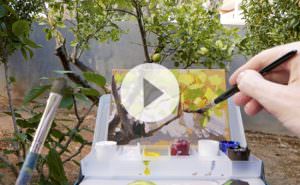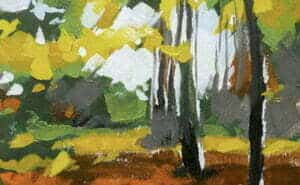Morning Class!
The new Floral Still Life Acrylic Painting Course is now available!
I’ve developed this course to show you how you can transfer the feeling of simplicity and light into a studio floral still life by the arrangement of colours, composition and tonal value range.
Taking classical painting techniques to build up an indirect painting in acrylics you’ll create a more contemporary still life painting that allows you to use a light modern palette and still see a good three-dimensional form.
You can read more about the course here and watch an introductory video here
Cheers,
Will






Do you have any plans on developing a Watercolor for Beginners course? :)
Hi Constantin, nice to hear from you, I haven’t got any plans for a beginners watercolour course at the moment, but good to know it would be of interest. I do a few watercolour sketches on the landscape sketching and urban sketching courses using brush pens and watercolour pans you might find of interest, mostly they are a combination of pen and wash, similar to this tutorial.
Cheers,
Will
Understood. I’m going to take the two courses you recommended. Who knows, by the time I finish them, maybe more people will try to persuade you to consider creating a watercolor course :) Thank you so much for your courses!
Ha, ha, really hope you enjoy the courses Constantin.
Will
Such perfect timing- it’s just the type of technique I was looking to brush up on! Just bought the course and I look forward to working my way through the lessons! And it’s exactly what I needed- I’ve been working exclusively with a couple different sizes of filbert brushes, I feel like it’s holding me back by not learning to use the other brush styles.
My thanks! Truly enjoy your site and your courses- best out there, BY FAR!
Hey Lauren, that’s great to hear! thanks very much. Those filberts can work a treat, really hope you enjoy the new course and thanks for your kind words on the lessons, can’t wait to see how your peonies turnout.
Cheers,
Will
Hi Will,
I’ve just bought the course. And can’t wait to get started.
I’m wondering whether I could also just paint it on acrylic paper to have it framed just the way It’s done on the wall behind you. Is that also 30 x 30 in size?
Thanks. Love this course!
Sabine
Thanks Sabine, really pleased you’ve been enjoying the course. Yes, you could paint onto acrylic paper and mount within a frame. The canvas size is 30 x 30cm. Hope your paintings goes well.
Cheers,
Will
Hi Will,
I just finished this floral still life course — fascinating and very well done. I like how you’ve framed the finished piece — can you tell us about that? Since it was done on deep stretched canvas, I’m assuming that’s a linen liner and not a mat? And if you use a linen liner on an acrylic painting, would you use glass? I don’t want the reflection of glass to spoil the enjoyment of really being able to study the finished framed painting. Thanks, love watching you paint.
Marcia
Hi Marcia, really pleased you enjoyed the course!
I wouldn’t use glass on the framed canvas but I would varnish to protect the surface and even the sheen. The canvas was ‘float mounted’ (or float-framed) so the edge of the canvas is still visible, I’ll often have a small 5mm gap, but in this case it was framed close to the canvas.
Hope this helps,
Cheers,
Will
Thanks Will, very helpful. In the introductions where you are standing in front of the framed painting, it looks like there is a white mat all the way around the painting before the white frame. Is that part of the frame? That’s what I thought was a liner. I like the white separation between the painting and where the frame comes forward and I can’t tell what that white area is — are you saying that’s not a mat or a liner, but is part of the frame itself? I’m having trouble learning how to frame my acrylic paintings well.
Hi Marcia, the white area is not a linen liner, but part of the frame I have made bespoke for me. You could equally create this look with a white inlay mountboard that’s then attached to an outer frame for the same aesthetic.
Cheers,
Will
Hi Will
I have followed your free online tutorials for a couple of years and have had some success. My husband decided to buy me this floral course and I have just finished the painting and I have to say it was such a lovely experience to go through the whole process with instruction along the way. I am very pleased with the results and I’m inspired to take on new challenges. I would say that this course helps to free up one’s style to paint more loosely which I have struggled to get away from and often my style can look a bit cartoon like. I’m currently trying my hand at oils and some portraiture and hope to be able to start another course soon.
Jan
Hi Janet, great to hear from you and so pleased you’ve been enjoying the new still life painting. Glad that you’re feeling inspired to tackle your own subjects and develop a more realistic style using methods from the course. Enjoy your oil studies!
Cheers,
Will
Afternoon Will,
I wonder if you can help me, I’ve purchased both your Venice and Flower painting course and need to buy some new brushes. I have bought some W&N water mixable oils I was thinking about getting some Rosemary & Co brushes and I noticed you use both the Ivory and the Evergreen range. Which do you recommend and how do they differ?
I have in the past used both pure hog of various makes and Daler Rowney system 3 syntheticfor with acrylics.
Hope you can help and look forward to hearing your thoughts.
Lisa
Hi Lisa, the ivory is a synthetic hog and the evergreen is 100% synthetic fibres (like your system 3 synthetic for acrylic). The Ivory is stiffer than the evergreen (closer to a nylon/hog blend) so preferable if painting with thicker more impasto paint.
Hope this helps,
Cheers,
Will
Hi Will,
while in the grip of insomnia this week, I’ve been coming to your site and catching up on your posts to see what you’ve been up to in the last couple of years, since I took some of your excellent courses.
Your videos are so restful and inspiring and I love your posts!
I’m going to get this course to reactivate my drawing and classical painting skills, (such as the latter are!)
Thanks for all that you do!
Good one Helena, really hope you enjoy it!
Cheers,
Will
Love the flowers eeeeee.Hi, I enjoy your writing..your freaking amazing as an artist and how you teach…inspires me. I want to learn to draw and paint and own an art gallery. Be an art Dealer.I am reading your stuff..u wow…….I went wild when I saw the flower you painted I said I want to do that I love flowers and read up on em…The paintings of the buildings are exquisite.I was drawn to European architecture..I realized how I want to paint buildings and landscapes…Spain inspired me..I saw it”s landscape on tv went bananas..Will visit one day especially seaside and paint it…Yes, my mother’s clan are all artistic, I caught on too late…My dream is to visit Italy ve transformed…reading up on 14th century art…it just fascinates me.
Thanks very much Sabina, so glad you’re feeling inspired for your paintings.
Cheers,
Will
Hi Will, I took he course and loved it! You have the best videos around. So clear and a joy to follow
Thanks very much Julie, so glad you enjoyed the floral course and found it easy to follow.
Cheers,
Will